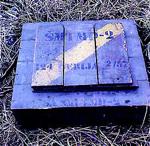Mine abolition

An abolished Anti-People Mine. It’s supposed to kill or mutilate a single person.

A not abolished Anti-tank mine. It kills or mutilates several people in vehicles. It doesn’t differentiate between a tank, a truck or a school bus …

The men of MgM take matters in their own hands, literally handling deadly mines and dangerous left-over ammunition problems on an everyday basis. We deal with the explosive remnants of war left for an innocent population by the military and the politicians who are too often completely indifferent to their needs. This is what we call being "active for peace".
Critical points of view about the ban on Anti-Personnel mines
The Nobel Peace price is fine and good, but...
Without any help from us, MgM has become a member of the international representation of the ICBL - International Campaign to Ban Landmines - (NOT of the German movement!) and consequently, but unintentionally, co-recipient/laureate of the Nobel Peace Prize.
Since the ban is related only to anti-personnel mines and not to tank or other mines we have conflicting feelings about this association. Particularly, when the ban is used against the interest of the affected people – in ways which no one foresaw.
The boomerang
Signatories refuse to provide means for humanitarian de-mining for countries like Angola, one of the three most severe mine affected countries in the world, at first because Angola did not ratify the Ottawa treaty, and then because of rumours that Angola did not meet the obligations of the treaty. In this way, the people become not only victims of mines, but also hostages of the self-righteous signatories. One can't be proud of that...
The International Campaign to Ban Landmines may have received the Nobel Peace Prize, but this failed to reduce the suffering of the people. On the contrary, some governments and misinformed public believe that with the Ottawa treaty the job against mines is done. Also some mine producers use the ban, since the ban opens up a market for already existing and enormously expensive new mines.
Catching the boomerang
All that is true. And MgM must have profound regrets about what the Ottawa Convention does not cover - especially those mines that got left out of the ban definition. But the treaty has actually achieved some things. It has raised the public profile of the humanitarian APM situation and it has convinced a large number of governments to change their public policies of mine use. How much difference that makes is hard to know. More important perhaps, it has drawn together a lot of clever activists who have begun to address the giant problem of limiting all the explosive left-overs of war. They are working on getting diplomats to agree on how to solve the problems of the UXO and mines that the ICBL did not cover. No one predicted that would happen. The Ottawa Convention was just step one - and the Nobel prize was very premature. The most important thing is to seize the time and keep the momentum of humanitarian concern. Everyone involved - campaigners, diplomats, governments and deminers - must get on with their job more urgently.
Active for peace
MgM is naturally and fundamentally opposed to the production, distribution, storage and use of Anti-Personnel mines, but also against the manufacture and use of all other mines and weapons and, of course, war.
Our roots are in the peace movement (especially the American Hippies). In contrast to other known mine clearance organizations, we are civilians, radical pacifists and weapon destroyers. Under no circumstances could we be thought of as band-wagon jumping ex-military types or pencil pushers. This doesn’t always sit well with everybody but as long as our mine clearance systems and the social economic results of our operations are setting new standards world-wide, we don’t care. We are not politicians, but humanitarian specialists in the service of fellow human beings who are terrorized by mines.

Abolished Anti-Personnel mine

Non-abolished Anti-Tank mine

Non-abolished submunition from a cluster bomb
MgM demands general abolition of all mines
There are no good or "intelligent" mines. To a deminer or a civilian victim, there is no significant difference between the banned anti-personnel mine (AP), an anti-tank mine (AT), or unexploded munitions (UXO). Anti-personnel mines regularly kill and maim civilians. But anti-tank mines regularly kill civilians traveling on trucks and buses – and unexploded submunitions have been an extremely effective killer of children since the conflict formally ended in Kosovo.
It is impossible for us to accept that an ‘un-abolished’ anti-tank mine somehow has international legitimacy when it blows up a school bus. Similarly, we do not understand the contorted logic that legitimizes the use of a so-called "intelligent" mine that tears apart women and children who are looking for firewood. Changing the name of a "mine" to a "ground protection system" does not change its effect on its victims.
The international campaign to ban anti-personnel mines (ICBL) did receive a Nobel prize, but it has not reduced the suffering of those afflicted by landmines. On the contrary, some governments and members of a misinformed public believe that the Ottawa accord did enough on its own to make landmines no longer a problem. Also, some mine manufacturers have used the restrictions of the ban to open markets for highly expensive new mines that they had already developed. While they use the ban to boost their profits and sell "improved" mines, the financial support for humanitarian mine clearance is getting harder and harder to find.
Even the British Diana fund doesn’t help much. From the many millions donated to mineclearance, only 250,000 pounds have been channeled to two mine clearance organizations.

The working principal of hand-held metal detectors hasn’t fundamentally changed in decades. New ways of sensory detection are being researched. But none of the new and expensive and complicated technologies are being used in the daily work of deminers. MgM will continue to work with the best and most reliable metal detectors that are currently available.
Hi-Tech Sensors often misleading
Mines come in all different colors, sizes and shapes. The only thing they have in common is the explosives and how they get triggered by their victims..
Huge budgets are spent on research into detector technologies, and often - it seems - without any base in reality, as in the case of Bengo. It is frightening that this research and development is often conducted by mine manufacturers so that the money and the research results are used to not only "improve" the mines but the manufacturers also want to profit from the demining.
There are only a few promising ventures into Hi-tech sensors, and it will take years before they are ready to be implemented. It is questionable whether they are going to be affordable even then.
Nothing is good, unless you make it so...
In the meantime, organizations like MgM are clearing with existing equipment and are achieving concrete humanitarian results. Mines can neither be discussed-away nor vaporized by written contracts. They must be cleared.
Clear landmines now!





